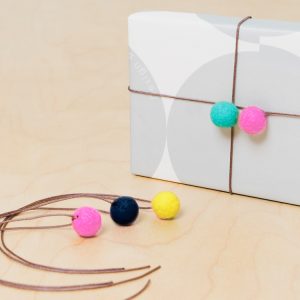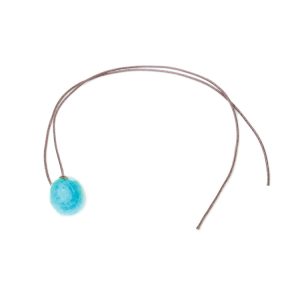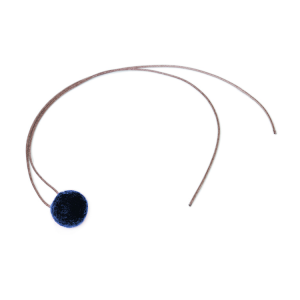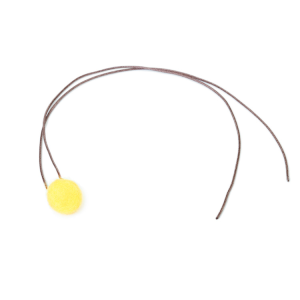Bookmark; Product development & manufacturing episode
Introducing here is “Bookmark” (small felt bookmark), a simple bookmark with a small felt ball.
It is manufactured at NPO Suginami Izumi in Tokyo, Type B facility for continuous employment support service (Suginami Izumi second). We interviewed Watanabe-san, staff member, and Hoshiko-san, designer, about the development and manufacturing episode of “Bookmark.”

Please tell us about the inspiration and concept behind the product you designed.
Hoshiko-san: First of all, let me start how I first met equalto. I applied for the equalto award 2014 and were selected, and we released a product called “Teruteru,” Teruteru-bozu (a doll wishing for good weather) shaped shoehorn. I have always been interested in manufacturing products by people with disabilities, so I was eager to participate in such an initiative.
Team staff: What sparked your interest?
Hoshiko-san: My brother works at a special needs school, and I often heard stories about school life. I visited the school to see if there were anything I could help with, such as in the craftmanship class.
Team staff: You had that background. Was there anything you kept in mind when developing the “Bookmark”?
Hoshiko-san: For “Teruteru,” I worked with the facility staff to create a design that required advanced handmade techniques, such as making the shape as symmetrical as possible. On the other hand, for “Bookmark,” I aimed to create a warm and welcoming product with a high degree of freedom that only handmade products can offer. I also tried to create a design that was more “barrier-free for the creators,” drawing on our experience with “Teruteru.”
Team staff: Your experience working with people at the facility to create things, allowed to design products that take advantage of the facility’s unique features.
What were the innovations you made in developing the products?
Hoshiko-san: With “Teruteru,” I visited the facility after the design was decided. This time, I started thinking about the design after visiting Suginami Izumi, where the products are made, in order to design with “barrier-free for creators” in mind.
Watanabe-san: How did you really feel after touring our facility?
Hoshiko-san: I felt that the workplace is full of vitality. So, I hoped that the production of “Bookmark” by users* would make it even more vibrant. Instead of creating a brand-new product, I aimed to create a product that would take advantage of Suginami Izumi’s specialty, felt balls.
*Facility users with disabilities
Team staff: I see. How did the idea of “Bookmark” come about?
Hoshiko-san: I tried placing the borrowed felt balls in various places in my home and office, and started to formulate ideas from scratch, wondering what they would look like and what functions would make them viable as a product. I suddenly thought, “I like the way this little thing on top” when it was placed on top of a book and decided to make it into a bookmark.
Team staff: The scene where you think this felt ball is cute in your life led to this kind of functionality.



What were the particulars in deciding on the size, color, string, etc. of the felt balls?
Hoshiko-san: I asked many people to look at the felt balls and give their opinions on the size and color. I received feedback from all ages, including my own child, my wife, and friends. As for the string, at first I thought of “should be one string” and went through a trial-and-error process, but after carefully considering the ease of production and the consumer, I realized, “Wouldn’t it be more convenient to have two strings?” and chose this style. Four colors are available, and they look colorful and cute lined up on the bookshelf.
Team staff: So, you went through various iterations to arrive at the current design. Watanabe-san, were there any points your team was particular about?
Watanabe-san: In order to represent the “I like the way this little thing on top” that Hoshiko-san felt, we paid close attention to the size of the felt balls, utilizing a jig that can measure diameters in one step.
Team staff: Thank you for making such an effort. I think it turned out to be a special product!

Finally, do you have any thoughts on “Bookmark” or a message for customers?
Watanabe-san: A number of people, including Hoshiko-san, were involved in the project to make it successful. Since the product is filled with many people’s thoughts, I hope the product will be loved for a long time by those who hold it in their hands, and it will bring a smile to those who receive it.
Hoshiko-san: I would be very happy if people like this product first and then learn that it was created with such a background. I think it would be fun if they found new ways to use this, such as wrapping a book with it as a gift, in addition to using it for themselves. I hope that this new form of manufacturing will spread, where “people with disabilities can make the most of their individuality and play an active role in cooperation with others,” while drawing people’s attention to the backgrounds and usages.
Team staff: We would be happy if more people could pick up the bookmark.





Takuya Hoshiko
Born in 1974, Kumamoto
After graduating from Kuwasawa Design School, worked for a design office and a general merchandise manufacturer before becoming independent.
Currently, works mainly in graphic design.
Winner of equalto excellent award 2014












